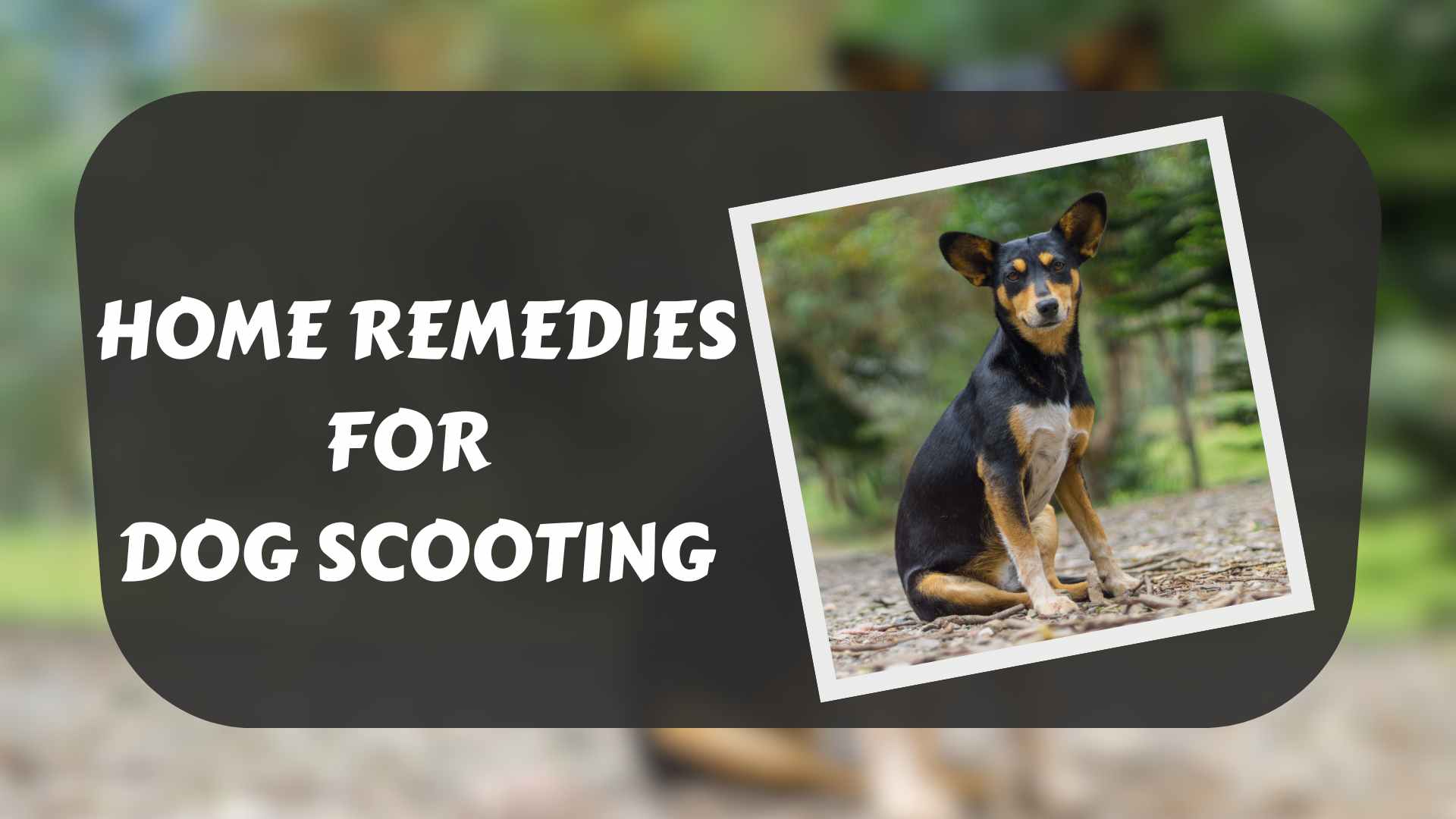8 Effective And Simple Home Remedies For Dog Scooting

Is your pup constantly scooting across the floor? This can be a sign of discomfort due to issues such as impacted anal glands or parasites.
We will discuss 8 effective and simple easy home remedies for dog scooting, equipping you with tips on dietary changes, grooming techniques, and natural treatments that can ease your furry friend’s distress.
Ready to put an end to the itchy bum blues? Let’s dive in!
Why Do Dogs Scoot?
Dogs scoot for various reasons, such as impacted or clogged anal glands, dirt or poop on their bum, parasite infestation, skin irritation, food allergies, constipation, and vaginal issues in female dogs.
Impacted Or Clogged Anal Glands
Dogs have two small bags in their bottoms called anal glands. These glands can get blocked or full sometimes. This might make your dog’s bum itchy. When this happens, your dog may sit down and scoot across the floor to relieve the itch.
If you see this, you should check your dog’s bottom for a bad smell. A bad smell could mean that your dog has an anal gland problem.
Dirt Or Poop On A Dog’s Bum
Sometimes, a dog’s bum has poop or dirt stuck to it. This might make them scoot across the floor. Their bum feels itchy and they try to wipe it clean. Dogs with long fur have this problem more often.
The poop can get caught in their fur after they go to the bathroom.
A dirty bum is not good for your dog’s health. It can lead to infections around the anus if you don’t take care of it right away. Make sure your dog is clean after each poop trip outside.
Use warm water and pet-safe wipes for cleaning if needed.
Parasite (Tick/Flea) Infestation
Ticks and fleas can make your dog scoot. These bugs bug the skin around a dog’s bum. This leads to itching and pain. Your dog may feel better by rubbing its bum on the floor, hence the scooting.
Also, if your pooch eats a flea that has worm babies inside it, there is another trouble. It can get tapeworms from this small snack! An itch or pain in the anal area can come from this too.
Some dogs keep scooting even after getting worm medicine. Make sure to check for these pesky parasites when you see your dog scooting across the floor.
Skin Irritation Due To Infections Or Grooming
Skin irritation due to infections or grooming is another common reason why dogs may scoot. Infections in the skin around their anus can cause discomfort and itchiness, leading them to scoot across the floor.
Grooming products like shampoos or wipes can sometimes irritate their sensitive skin and trigger scooting as well. To help alleviate this issue, you can clean your dog’s bottom with gentle, hypoallergenic wipes or a warm washcloth.
It’s important to avoid using harsh chemicals or fragrances that may further irritate their skin. Additionally, keeping your dog’s fur trimmed around the anal area can prevent dirt and bacteria from accumulating, reducing the risk of infection and irritation.
Food Allergies
Food allergies can cause intense itching around your dog’s bum, leading to scooting. Food sensitivities, especially to proteins like beef or chicken, can contribute to this problem.
It is important to identify and eliminate any potential allergens from your dog’s diet to prevent further discomfort. Certain dog foods are formulated specifically for dogs with food allergies and can help alleviate symptoms.
Constipation
Constipation can cause dog scooting. When your dog is constipated, it means that they are having trouble passing stool. This can lead to discomfort and straining, causing them to drag their bottom across the floor.
A low-fiber diet is often the culprit behind constipation in dogs. To help alleviate constipation and prevent dog scooting, you can make dietary changes for your furry friend. Add fiber-rich food to their diet, such as pumpkin or bran flakes.
These high-fiber foods can promote healthy digestion and soften the stool, making it easier for your dog to go potty without any scooting troubles. Additionally, fiber supplements like psyllium husk powder or canned pumpkin puree can be added to their meals to further aid in relieving constipation and reducing scooting incidents.
Vaginitis Or Related Issues In Female Dogs
Female dogs can experience vaginitis or other related issues that may cause them to scoot. Vaginitis is a condition that causes inflammation and infection in the vagina, leading to discomfort and itchiness.
When female dogs have vaginitis, they may scoot or drag their vulva across the floor as a way to relieve the itching sensation. Another related issue is vulvar dermatitis, which also causes irritation and itching around the vulva area.
Dogs with this condition may excessively lick or scoot in an attempt to find relief. It’s important for pet owners to be aware of these potential problems so they can seek proper veterinary care if their female dog exhibits any symptoms of vaginitis or related issues.
8 Effective And Simple Home Remedies For Dog Scooting
Here are some simple and effective home remedies to help relieve your dog’s scooting problem.
1. Sanitary Clipping And Cleaning
Keep your dog’s anal area clean to prevent scooting. Here are some easy home remedies you can try:

- Trim the hair around your dog’s anal area regularly. This prevents fecal matter from getting stuck and causing discomfort.
- Use gentle wipes or mild soap to clean the area. This helps maintain good hygiene and reduces inflammation.
2. Warm Compresses With Water
To help ease the inflammation of your dog’s anal sacs, you can apply a warm compress to their bum. This can provide relief and decrease discomfort for your pup. Here’s how you can do it:
- Prepare a warm compress by soaking a clean cloth or towel in warm water.
- Make sure the compress is not too hot, as it could burn your dog’s sensitive skin.
- Gently wring out any excess water from the compress.
- Carefully place the warm compress on your dog’s bum, specifically around the area where they are scooting.
- Hold the compress against their bum for a few minutes, allowing the warmth to penetrate and soothe their anal glands.
- Repeat this process a few times a day, as needed.
3. Anti-Inflammatory Treatments
To help reduce inflammation and provide relief for your dog’s scooting problem, you can try these anti-inflammatory treatments:
3.1 Witch Hazel
It is a recommended treatment for dogs with scooting issues. Witch hazel has anti-inflammatory properties that can soothe itchiness, inflammation, and soreness in your dog’s rear end.
3.2 Apple Cider Vinegar
This natural remedy can be effective in reducing inflammation in dogs with scooting problems. You can mix apple cider vinegar with water and apply it to the affected area using a clean cloth or cotton ball.
3.3 Calendula Compresses
Calendula is a herb known for its natural anti-inflammatory properties. Applying warm compresses made with calendula-infused water can provide relief and decrease discomfort in your dog’s rear end.
4. Epsom Salt Or Calendula Compresses
To help relieve your dog’s scooting, you can try using Epsom salt or calendula compresses. These remedies can be beneficial for dogs with anal gland issues and reduce inflammation.
For a calendula compress, you can mix a teaspoon of salt with 8 drops of calendula and apply it to the affected area. Epsom salt can also be used by adding 1 to 2 teaspoons to warm water and applying the compress for 5 to 10 minutes, 3 to 4 times a day.
This will help increase blood flow to the anal glands.
5. Manual Expression Of Anal Sacs/Glands Using Your Fingers
To help alleviate your dog’s scooting problem, you can try manual expression of the anal sacs or glands using your fingers. Here’s how:
- Gently lift your dog’s tail and locate the small openings on either side of their anus.
- Put on a pair of disposable gloves to maintain cleanliness.
- Apply gentle pressure with your thumb and index finger around the anal gland area.
- Gently squeeze and massage towards the anus to encourage the release of fluid from the glands.
- Be careful not to squeeze too hard or cause any pain to your dog.
- If successful, you may notice a small amount of fluid being expressed.
- Afterward, clean the area with a pet – friendly wipe or damp cloth.
6. Dietary Changes For Anal Gland Health
If your dog’s scooting is related to anal gland health, you may consider making some dietary changes.
6.1 Fiber Rich Food
Feeding your dog fiber-rich food can help alleviate the discomfort and itching associated with dog scooting. Fiber helps regulate digestion and promotes healthy bowel movements, reducing the chances of constipation or impacted anal glands. Canned pumpkin is an excellent source of digestible fiber that can be added to your dog’s diet. Its high fiber content can help soften stools and prevent straining during bowel movements, making it easier for your dog to express their anal glands naturally.
6.2 Probiotics
Probiotics can be really helpful in treating and preventing dog scooting. These are good bacteria that support a healthy digestive system. Adding probiotic-rich foods or supplements to your dog’s diet can promote better digestion and reduce the chances of scooting.
6.3 Omega-3 Supplements
Omega-3 supplements, which contain fatty acids found in fish oil, can be incredibly beneficial for your dog’s overall health. These supplements help reduce inflammation and promote skin, coat health, prevents yeast infections that often lead to skin and ear problems. It also helps to strengthen the immune system and fight off allergies caused by parasites in dogs.
7. Increase Water Intake
To help manage your dog’s scooting problem, it is essential to increase their water intake. Keeping your dog hydrated is crucial in preventing constipation and promoting a healthy digestive system.
By making sure they have enough water to drink throughout the day, you can help prevent blockages and keep their stools soft and easy to pass. Adequate hydration also assists in maintaining the overall health of your pet, reducing the chances of skin irritation or infections that may contribute to scooting behavior.
8. Daily Exercise
Daily exercise is an important part of managing and preventing dog scooting. Regular physical activity helps keep your dog’s digestive system healthy and prevents constipation, which can be a cause of scooting.
Exercise also helps maintain a healthy weight, reducing the risk of skin irritation due to excess fat or folds in the skin. Daily exercise provides mental stimulation for your dog, reducing stress and anxiety that can contribute to scooting behavior.
So make sure to give your furry friend plenty of opportunities for playtime, walks, and other forms of exercise every day.
When To See A Vet
If your dog’s scooting symptoms persist or worsen, it’s essential to seek veterinary care. Persistent or worsening symptoms might indicate an underlying issue that needs attention.
While home remedies can provide temporary relief for mild cases of scooting, they may not address the root cause of the problem. It’s best to consult a veterinarian who can properly diagnose and treat your dog’s condition.
Swollen anal glands in dogs require appropriate treatment, and relying solely on home remedies may not be enough to resolve the issue effectively. Your vet will be able to determine the best course of action for your furry friend’s well-being.
Frequently Asked Questions
How Often Should I Apply Home Remedies For Dog Scooting?
You should apply the home remedy according to your dog’s individual needs. Generally, applying it once a day is sufficient. However, some dogs may require more frequent applications. Monitor your pup and adjust accordingly.
How Can I Tell The Difference Between A Scooting Dog And One With An Underlying Medical Condition?
You can tell the difference by observing your dog’s behavior and noting accompanying symptoms. If scooting persists over a few days, it could indicate an underlying medical issue. Check with your vet for health risks.
How Often Should I Clean My Dog’s Bottom?
Clean your dog’s bottom regularly, at least twice daily, with warm water and a washcloth or wet wipes. If scooting persists, consult your vet for further advice.
What Are The Long-term Effects Of Using Home Remedies For Dog Scooting?
The long-term effects of using home remedies for dog scooting are mainly unknown. It’s important to consult a veterinarian before attempting treatments, as some may cause unintended side effects.
To Sum Up
These home remedies offer vital help for your beloved pup’s scooting discomfort. From keeping their anal area clean to dietary tweaks, we’ve got you covered.
If the issue persists, consult your vet for expert guidance.
As a dog owner, I’ve been through it too, and I know how concerning it can be. Share your experiences and thoughts with us. Have these tips worked for your furry friend?
Don’t forget to share this valuable guide with fellow pet owners.







Useful tips, I will try
That’s awesome! I’m so glad you found the tips helpful. Please let me know how it goes, I’d love to hear about your progress.